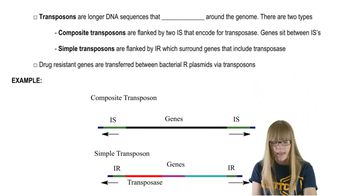Here are the essential concepts you must grasp in order to answer the question correctly.
Antisense RNA
Antisense RNA is a strand of RNA that is complementary to a specific mRNA strand. It can bind to the mRNA and inhibit its translation, effectively regulating gene expression. In the context of IS10, the antisense RNA regulates the translation of transposase, which is crucial for the transposition process.
Recommended video:
Transcriptional Efficiency
Transcriptional efficiency refers to the rate at which a gene is transcribed into mRNA. It is influenced by various factors, including promoter strength and regulatory elements. In this scenario, the POUT promoter is significantly more efficient than the PIN promoter, affecting the levels of antisense RNA and transposase produced, which in turn impacts transposition.
Recommended video:
Transposition
Transposition is the process by which a transposable element, such as IS10, moves from one location in the genome to another. This process is mediated by the enzyme transposase, which is produced in response to the transcription of the transposase gene. The efficiency of transposition is directly linked to the levels of transposase and the regulatory mechanisms controlling its expression.
Recommended video:
Prokaryotic Transposable Elements






